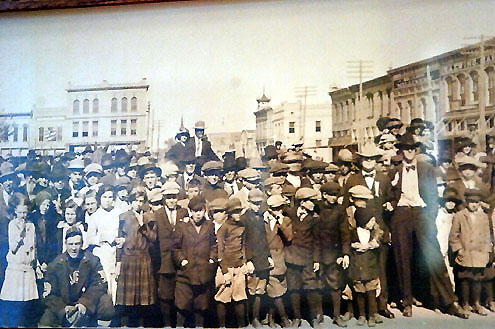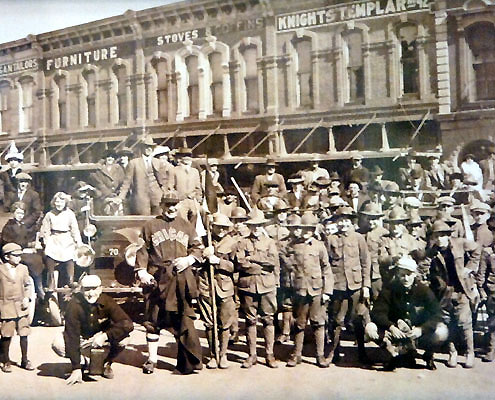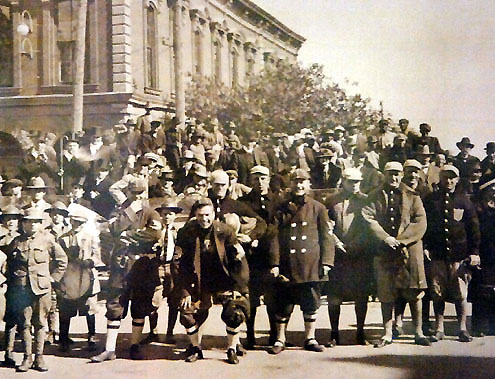If you ask about the biggest game ever played in North Texas, expect to get a different answer from everyone that responds. But arguably the biggest game ever played may be one that very few people know about.
One team was managed by John J. McGraw, owner of the New York Giants. McGraw had Jim Thorpe in right field. This was a year after Thorpe had won Olympic gold medals in the pentathlon and decathlon. At second base was Larry Doyle, one of the top defensive players at his position in the history of the game. Although he wasn't scheduled to play that day, according to the local paper Christy Mathewson was leaning against the fence and joking with fans that were begging to see him pitch. Taking the mound that day for the Giants was Jeff Tesreau, another big right-hander with a pair of 20-win seasons to his credit.
Out in center field for a team managed by Charles Comisky and mostly consisting of his Chicago White Sox was Tris Speaker, a fine defensive player that also finished with professional baseball's fifth-highest lifetime batting average of .345. In right field stood Hall of Famer Sam Crawford. At shortstop was Buck Weaver. On the mound was Reb Russell, although he was known as "Lefty" growing up in Fannin County. Russell won 22 games for the White Sox that year and Shoeless Joe Jackson said that Russell was one of the two toughest pitchers he ever batted against. The year was 1913 and the White Sox were squaring off against the New York Giants in a section of Bonham, Texas known as Russell Heights.
Even the home plate umpire for this game earned a spot in the Baseball Hall of Fame. William Klem is the home plate umpire credited with first using hand signals to accompany his calls on ball and strikes.
So how did a little North Texas town land a game that featured many of the best-known athletes of that era? It is a wonderful story that would make an even better movie.
Chicago White Sox owner Charles Comisky was a man on the move. He had opened Cominski Park in 1910 and, following the 1913 season, Cominski and New York Giant manager John J. McGraw decided that a baseball world tour would help elevate baseball from the national sport to an international sport. The visionary team owners chartered three sleeper railroad cars, a sleeper/observation car and a luggage car before setting out on a 33-day tour that began in the Midwest, dipped south through Texas, played along the West Coast and then shipped out for the first professional baseball exhibition in Japan.
They started in Cincinnati, the birthplace of professional baseball, toured the orient and even played an exhibition game for King George of England. In the early part of the tour, towns along the Missouri-Kansas-Texas Railroad like Blue Rapids, Kansas and Bonham, Texas were fortunate to secure a game if they could guarantee $1,000 to the touring teams.
Some towns weren't so fortunate. The train didn't stop in Fort Smith, Arkansas, for example, because local officials had notified the team managers that they would be presented watch charms fashioned from nails used in federal gallows that had been used in over 100 executions. Superstitious players convinced Cominski and McGraw to skip that stop.
Other problems plagued the first stops of the tour. The weather can be unpredictable in Illinois, Iowa and Kansas in late October. In Peoria it was so cold fans burned part of the bleachers to stay warm.
In Tulsa, an overflow crowd was too much for the bleachers and 700 people were sent tumbling through the air when the seats collapsed. An Army private was crushed and killed. Dozens were taken to the hospital. The reason for the big crowd was because Walter "Big Train" Johnson had joined the tour to duel Christy Mathewson. Despite the tragedy, the game went on as scheduled and Johnson shut out the Giants.
Many years later, Sportswriter Jimmy Cannon became famous for saying, "Baseball isn't statistics. Baseball is DiMaggio rounding second."
Anyone that was lucky enough to witness Johnson and Mathewson, two of the game's all-time greatest hurlers, go head-to-head on this cross country train tour truly saw baseball history, regardless of the statistics logged that day.
After the game in Tulsa the next stop was Muskogee, Oklahoma and then Bonham.

The boys at the Bonham Daily Favorite called it a "Red Letter Day for Bonham" in their October 29 edition and the Chicago Tribune sent a telegraph to the Favorite office asking for a 300-word write-up of the game to be wired, along with the box scores.

The Favorite's subtitle for their article October 29 said it all:
This is the day we long have sought
and we'll be there, our tickets bought
The great big game twixt the Giants and Sox
With Lefty Russell in the box
Townspeople met the train at the MK&T Depot at 8:30 a.m. A reception committee consisted of Will H. Evans, Judge Rosser Thomas, Mayor W.A. Spangler and F.C. Allen. The band played and a parade under the direction of Phil Wise, Albert Crittenden, S.F. Leslie and George W. Jones took the ballplayers north on Main Street from Wholesale House to West 4th Street. The parade went down West 4th St. to the high school and traveled back east on 5th Street to the city square. The teams were driven by Carleton College and then taken to the Cotton Mill for a tour. It wasn't exactly Broadway, but the Giants were a world removed from New York City by now. A lunch at the Alexander Hotel, courtesy of the Board of Trade, came next.
When the ballplayer's train pulled in, the Daily Favorite made special notice of Lefty (Reb) Russell's new bride:
Everybody wanted to see Lefty and his bride, and those who saw Mrs. Russell were not in the least disappointed, as she is a beauty, and so pronounced by every lady who saw her, and of course the men say she is pretty.
(Another dated article in the local paper advised parents to bring their children and let them fish in the fish pond in the basement of the Union Presbyterian Church for only 10 cents.)
The weather was perfect on October 30. The Katy train that morning was packed and two westbound Texas & Pacific trains hit town with more fans about noon.
Teams took the field at 2:00 p.m.

Here is how the Daily Favorite set the scene:
The original John J. McGraw was in the bunch. The Favorite man "spoke" to him as the sailors say. Christy Mathewson, the idol of the fans -- big old good natured Christy -- was in uniform and in vain did the fans ask him to pitch just one little inning, but nary an inning pitched he.
Hometown hero Lefty "Reb" Russell lost the contest 4-1, although he only gave up six hits. Four White Sox errors allowed the runs. At one point the game was halted so Judge H.A. Cunningham could present Russell with a "real gold watch." Seventeen hundred local fans got to watch Tris Speaker and Jim Thorpe steal second. Everybody came out a winner. One local report noted that if there had been an election that day, Russell would have been elected to every office in Bonham.
Games in Dallas, Houston and El Paso followed. The tour headed west to play in Douglas, Arizona and then up the West Coast before embarking from Seattle on the Express of Japan for the first major league exhibition in Japan.
Note: This article began with a question about a photograph at the Fannin County Museum of History. Many thanks to the late Tom Scott and retiree Jean Dodson who staffed one of the best small-town history museums in Texas and special thanks to Barbara McCutcheon and staff at the Bonham Public Library for locating newspaper clippings. The boys at the Favorite called it a "game that will go down in history as the greatest attraction of the kind ever staged on a local diamond..."
I couldn't agree more.